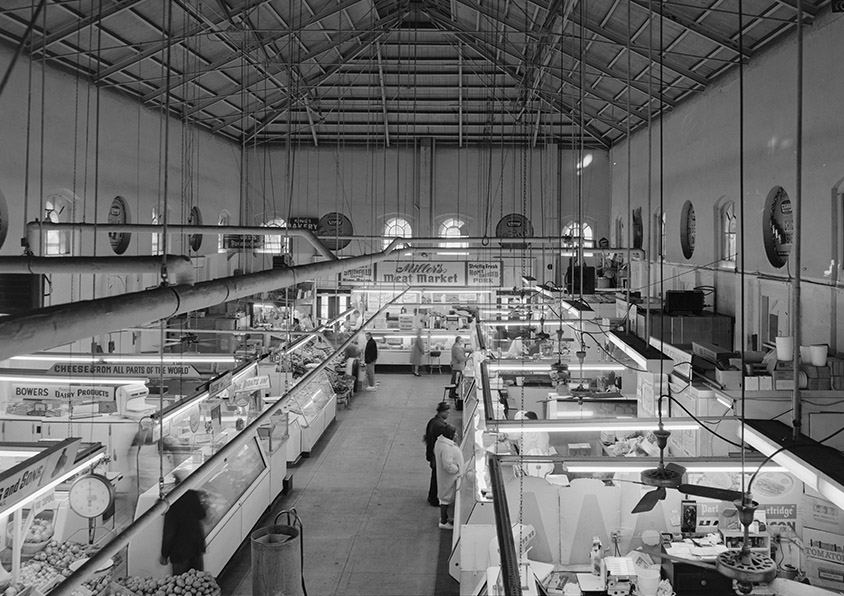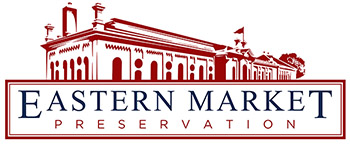
The original Pierre L’Enfant plan for the District of Columbia, developed in 1791, called for the creation of three Public Markets, a Central, Western, and Eastern Market.
In 1805, then President Thomas Jefferson issued a proclamation calling for the ‘Eastern Market” to be created at 7th St. and L. St. It was damaged during the war of 1812 and subsequently repaired. The Civil War disrupted the distribution of fresh food supplies and the Market fell into disrepair.
The current “Eastern Market”, located at 7th and D C SE, was designed by Adolf Cluss and was built in 1873. The Center Market closed in 1931 and the Western Market was razed in 1951. The Eastern Market has endured.
Since that time, the Market has primarily served as the principal fresh food pantry for residents of the surrounding Capitol Hill’s 6th Ward District. It has also served all District residents and tourists as a place to buy fresh and locally produced foods and handmade arts and crafts.
Throughout its history, there were attempts led by local developers or the District government to transform the Market into something other than the beloved fresh food Market that has endured for 145 years.
Health inspectors tried to shut it down in 1907 and 1917. District government planners had plans to demolish the building in 1928. In 1943, District government proposed transforming Eastern Market into a “streamlined supermarket”. In 1953 the District government proposed that it become a children’s theatre. In 1955 the city License chief declared the Market to be uneconomical and advocated its closure. And, in 1964 the District Health Commissioner declared the Market a “Menace to Public Health”. He suggested replacing it with a “huge supermarket with plenty of parking”. Later in the 1960’s, there was a proposal to run a freeway through the site and in 1981 the District developed a plan to transform Eastern Market into a “quaint tourist Bazaar” In 1985, plans were developed to add a mezzanine “boutique” to the Market. (See Washington Post, May 6, 2007 article “Eastern Market’s history of survival).”
The more recent attempt at the destruction of the Eastern Market should be seen in the context of the Urban Renewal (Urban Removal) movement. This mentality targeted anything historical and traditional as “out-of-date” and in need of renewal with “modernity”. Under this principal, Main Street businesses throughout the country were ripped out and replaced by strip centers and shopping malls. Magnificent historic buildings were bulldozed by the thousands and replaced with box-like office and condo towers. The wrecking ball literally destroyed thousands of Public Markets.
In Washington DC, every time the Market’s demise was planned by District government, neighborhood residents rose up to try and put a stop to it. Endless street protests, petitions, public hearings, and public outrage led to the preservation and continued operation of the Eastern Market as the place for which it was originally designed – as a fresh food and farmer’s Market.
When a three-alarm fire struck the Eastern Market in 2007, the District government wisely agreed to rebuild the historic Market. Thankful neighborhood residents demonstrated with placards that read “Please don’t fix it up too much.”
Following the fire, a 5-1-2007 article in the Washington Post observed”
“A successful city is a collection of successful neighborhoods, and the popularity of Cluss’s market building means the loss isn’t just to the residents of Eastern Market. The economic vibrancy of the neighborhood has been due, in part, to the power of Cluss’s market to attract people from across the region. It broke all the usual rules of contemporary shopping: There were no aisles, no chutes to feed the crowd through a phalanx of cash registers, no carefully calculated funneling of customers for the maximum economic squeeze. There was, instead, a vibrant mob crowded into a single, bustling, wonderfully disorganized space. It was a brick box that forced you into proximity with strangers, a drug powerful enough to attract suburbanites in number.
Rebuilding Eastern Market will be particularly difficult because it was a social space. It reeked of a century of sour milk and fish and fried food. The danger is that it will be closed so long that the vendors leave and the crowds dry up and with a new grocery store opening just down Pennsylvania Avenue, suburban habits of car shopping will supplant the local habit of walking home with too many bags cutting into the flesh of your fingers.
The temptation to ruin it will be strong. It could be cleaner, filled with new vendors, managed more corporately to supply a more predictable stream of yuppie foodstuffs. The test for the neighborhood, and for the city, will be to resist anything that changes the social character of the building as it was on any given Saturday afternoon. The challenge will be to rebuild where it was, as it was, and what it felt like.”
Thankfully, following the fire, the Eastern Market was successfully rebuilt and repopulated with a mix of many of the same merchants that had contributed to its success over the century. Many of the current fresh food merchants still enjoy high ratings among various lists of the best in DC.
Today, however, the Eastern Market is in danger of falling to many of the same forces that have historically tried to undermine it.
From Zaretsky report DC Eastern Market: How to Save an Endangered Treasure. May 21, 2018.
